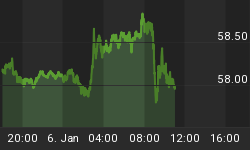Secular Low in Long-Term Bond Yields Coming Up
Hoisington's bond managers, Lacy Hunt and Van Hoisington, doubt the global economy will rebound soon thanks to low industrial output, heavy debt, and the commodities collapse. No Inflation In Sight, Say Two Bond Masters.
Since the 2008-09 Great Recession, it has been an article of faith in many circles that the loose monetary policy of zero-bound short-term interest rates and successive rounds of quantitative easing would lead ineluctably to a ruinous surge in inflation and interest rates. Yet just the opposite has occurred.
Much of their continuing dour outlook on U.S. and global growth revolves around the explosion of combined private and public debt as a percentage of economic output. According to Hoisington, in the U.S., that has jumped from 200% in 1987 to about 370%. In the euro zone, it has gone from about 300% of GDP in 1999 to more than 460%. Japan's debt stands at a monstrous 650% of GDP, while China's total debt has quadrupled since 2008, to 300% of GDP. And that's probably a conservative measure, considering that China consistently juices its GDP growth numbers.
According to Hunt, the growing debt load, especially in the past decade, acts as a blanket of snow and ice, freezing growth. Money is wasted by financing temporary boosts in consumption, rather than being used for sensible capital spending and infrastructure projects that would yield much future growth. As China has shown, capital investment is unproductive if it just builds highways to nowhere, redundant industrial capacity, and empty housing complexes.
Debt growth is sustainable only if the projects it underwrites produce a stream of income sufficient to repay the interest and principal.
According to Hunt, overindebted economies have certain telltale characteristics. Jumps in economic growth, inflation, and high-grade bond yields prove short-lived because debt constrains economic activity. Difficulties in making debt payments, in turn, push economies into frequent downturns and hurt productivity. Monetary policy loses effectiveness as the debt overhang stunts expansion of the money supply, slows monetary velocity, and quenches the animal spirits of producers and confidence of consumers.
Hunt sees just such trends at work in the U.S., where industrial production dropped 1.8% in December from the year-earlier level, despite a red-hot automotive sector. One can argue that manufacturing employment accounts for under 10% of total U.S. jobs. But, as Hunt points out, the U.S. industrial sector, according to Fed estimates, delivers about a quarter of GDP on a value-added basis. Likewise, industrial activities generate more than 65% of the earnings of S&P 500 stocks, he adds.
Finally, Hunt contends, much of the disappointing U.S. output growth during the current economic recovery can be laid at the feet of the Federal Reserve and unintended negative side effects of its loose money policy.
Citing research by Nobel laureate economist Michael Spense and former Fed governor Kevin Warsh, Hunt claims that the U.S. central bank's successive waves of quantitative easing diverted funds from productive uses in the real economy and into financial assets, sending the latter's prices higher.
Hunt realizes that the decades-long slide in U.S. government bond rates can't go on forever. He and Hoisington, as confirmed monetarists, are watching closely for any significant pickup in monetary growth and velocity that would indicate a possible surge in inflation. But as long as tepid industrial-output gains and disinflation obtain in the U.S., the Hoisington funds will continue to ride the long end of the bond curve.
Or, as Hunt and Hoisington put it in their January client letter: "In short, we believe that the long-awaited secular low in long-term Treasury bond yields remains ahead."
This Storm Will Pass
Compare Hunt's position with that of Barron's current cover story by Gene Epstein: "This Storm Will Pass". Epstein says the U.S. economy will avoid a recession and grow at a 3% pace this year.
I side with Hunt, mentioning Epstein in my February 22 post Real Time Tax Data Consistent With Recession.
No Inflation in Sight
I have had the same views as Hunt for quite some time. When others predicted hyperinflation, I called for record low yields in treasuries.
That said, there's plenty of inflation, depending on how you define the word. As a result of perpetually loose monetary policies, the Fed has blown asset bubble after asset bubble. Those bubbles and the corresponding huge expansion of credit along with it, constitute inflation in my book.
Asset Bubble Deflation
The problem for central banks is bubbles burst by definition. And when bubbles burst, the corresponding asset deflation makes it impossible for all the debt that has been issued to be paid back.
As long as credit on the balance sheets of banks is not in question, everything seems OK. The moment the market doubts that credit can be paid back, huge troubles begin.
We are at that point now, globally. European bank shares have been hammered.
- Europe's Largest Bank, HSBC, Posts Surprise $858 Million Loss: Analysts Expected Profit of $1.95 Billion.
- Eurozone Recovery is Over: Deflationary Pressures Intensify as Growth Slows
- ECB Admits 5 Banks Don't Meet Capital Requirements; Cockroach Theory Does Not Stop at Five
In Japan, Safes Sold Out: Customers Hoard Cash in Response to Negative Rates.
It's asset deflation not CPI deflation that central banks ought to fear. Even the BIS agrees with that statement. For discussion please see Historical Perspective on CPI Deflations: How Damaging are They?
Myopic central banks and their foolish attempts to halt benign consumer price deflation have once again brought about very destructive asset deflation that they should have been worried about.
Nonetheless, Central bankers never learn. Damn the Side Effects, More Stimulus Coming.
















